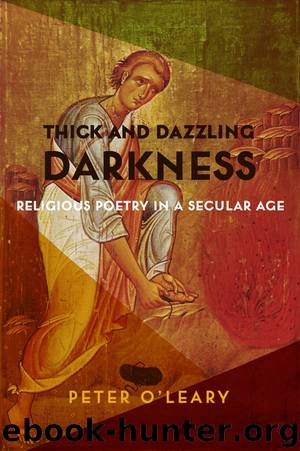Thick and Dazzling Darkness: Religious Poetry in a Secular Age by Peter O'Leary

Author:Peter O'Leary
Language: eng
Format: epub
Tags: Literary Criticism, Poetry, Subjects & Themes, Religion
Publisher: Columbia University Press
Published: 2017-11-21T01:16:16.015000+00:00
HORIZONTAL READING
In passing beyond humanity, in rising into the imagined infinite in her poetry, where death and transfiguring knowledge await, Wolsak requires a different strategy of reading, one that deliberately sidesteps her obscurities and seeming difficulties of legibility and meaning. I propose we read Wolsak, as I have been attempting, horizontally rather than vertically. I take this notion from the arguments of John Dominic Crossan, a scholar of early Christianity who has suggested that the four canonical Gospels yield a vastly different—implicitly more interesting—story when read horizontally rather than vertically. Crossan suggests that because the four Gospels were chosen for deliberate theological reasons to represent the “true” story of Christ, they each offer consistently different versions of his life and teachings, which, through the centuries and through negligent reading habits, we have synthesized into a whole, “true” story of the life. So, for instance, we might speak of Christ’s sufferings in the Garden at Gethsemane, without realizing that Mark’s Gospel speaks only of a garden where Christ went to suffer on the night before his crucifixion, begging mercy from the Father, while John’s Gospel speaks of Gethsemane, where Christ triumphantly confronted the Roman centurions, willingly giving himself over to his captors.37 Over the centuries, Crossan claims, we have moved from understanding the Gospels as interpretations to perceiving them as immovable, literal fact. He implies, then, that a horizontal reading of Gospel texts—a method reopening them to interpretation and heuristics—reveals meaning, whereas reliance on vertical, consecutive readings tends to obscure meanings and the theologies that drive the sequencing in the first place. By invoking Crossan’s understanding here, I don’t mean to suggest we take Wolsak’s poetry as gospel. Rather, I want to appropriate Crossan’s notion of reading toward understanding Wolsak’s writing. Reading Pen Chants, for instance, as a consecutive sequence might distort its meaning, misleading one to a progressive reading of its lyrics. Reading it mosaically—or horizontally—allows for its images and ideas to settle into a holographic image.
I am not entirely certain what a horizontal reading of Wolsak’s poetry would look like. I take my own reading of her work as a provisional beginning. The real difficulties of her work—a kind of (en)tranced grasping after gnosis—are too easily sold short by a fixation on the veneer of lexical, syntactical difficulty, which can flatten the effect of the work. In bringing some of the tools or ideas of religious studies to looking at poetry, I want to suggest a different—let’s call it horizontal—approach to difficulty. Rather than excusing difficulty as a byproduct of a manipulation of language, let’s use it as a door into another room or universe of thought.
Wolsak’s composition practices bear out this notion of a horizontality at work in her writing. The production of a poem for Wolsak is a layered, cumulative process, one in which she immerses her senses into the act of writing. She begins by noting words, fragments, soundbites, and neologisms in a notebook she carries with her everywhere. She then highlights what seems important from these notebook fragments, writing them out longhand onto “great big drawing sheets.
Download
This site does not store any files on its server. We only index and link to content provided by other sites. Please contact the content providers to delete copyright contents if any and email us, we'll remove relevant links or contents immediately.
4 3 2 1: A Novel by Paul Auster(12283)
The handmaid's tale by Margaret Atwood(7679)
Giovanni's Room by James Baldwin(7191)
Asking the Right Questions: A Guide to Critical Thinking by M. Neil Browne & Stuart M. Keeley(5633)
Big Magic: Creative Living Beyond Fear by Elizabeth Gilbert(5610)
Ego Is the Enemy by Ryan Holiday(5294)
The Body: A Guide for Occupants by Bill Bryson(4974)
On Writing A Memoir of the Craft by Stephen King(4863)
Ken Follett - World without end by Ken Follett(4645)
Adulting by Kelly Williams Brown(4487)
Bluets by Maggie Nelson(4473)
Eat That Frog! by Brian Tracy(4435)
Guilty Pleasures by Laurell K Hamilton(4360)
The Poetry of Pablo Neruda by Pablo Neruda(4039)
Alive: The Story of the Andes Survivors by Piers Paul Read(3968)
White Noise - A Novel by Don DeLillo(3954)
Fingerprints of the Gods by Graham Hancock(3940)
The Book of Joy by Dalai Lama(3899)
The Bookshop by Penelope Fitzgerald(3775)
